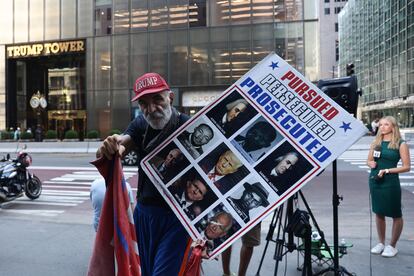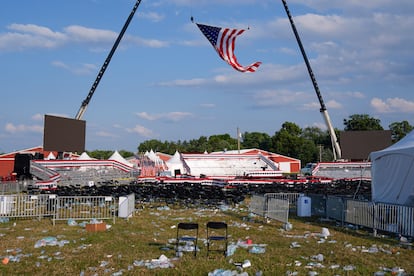Polarization, security failures and pro-gun laws: The ideal breeding ground for the Trump assassination attempt
The attack on the former president has sparked questions about the logistics of the event and whether politicians are responsible for fomenting tensions in the United States


The United States woke up on Sunday still in shock over the assassination attempt on former president Donald Trump at a rally in Butler, northwest of Pennsylvania. And, with a battery of questions in need of urgent answers.
Were the actions of Thomas Matthew Crooks — the 20-year-old young man who lightly injured the former president and killed one person — a consequence of the growing polarization being fueled every day by both sides of the political spectrum? How did security protocols fail and allow a shooter to easily take aim at Trump from the roof of an industrial building, just 150 meters from where he was addressing thousands of his followers? Did the secret services and local and state authorities — who some witnesses say were warned minutes before of the shooter’s presence — take too long to act? And would stricter gun control laws have prevented an assassination attempt that has resurrected the worst memories of the history of political violence in the United States?
Trump himself tried on Sunday morning to respond to the first of the questions — to his political benefit — in a message on his social network, Truth Social: “In this moment, it is more important than ever that we stand United, and show our True Character as Americans, remaining Strong and Determined, and not allowing Evil to Win.” It is ironic that this has been posted by the same person who has fueled the false accusations that the 2020 elections were stolen and that Joe Biden — who also called for unity after the assassination attempt — is an illegitimate president. This also the same person, who following his defeat, later instigated a mob of his supporters to storm the Capitol on January 6, 2021.
That episode marked a before and after in the political polarization that has been growing between the two Americas for years — a situation that was exacerbated by the Covd-19 pandemic. A completely paralyzed Congress — a victim of the standoff between Democrats and Republicans—; ultra politicians like Marjorie Taylor Greene exchanging decorum for personal attacks; and the misinformation encouraged by social media are the ingredients of a dangerous breeding ground. It’s the ideal recipe to spread the feeling that this is the most polarized America has been in its modern history.
These widening social divisions have brought to mind the particularly turbulent electoral campaign of 1968, when Robert Kennedy and Martin Luther King were both assassinated. Perhaps that is why, after learning of the attack, the Democrats announced that they were stopping the broadcast of electoral advertisements, which often feed shamelessly on the rhetoric of confrontation. A few hours later — after a brief mirage of calm — both parties accused each other of instigating the attack against Trump with their partisan rhetoric.
Amid the growing polarization in the United States, there is talk that there is a rising danger that the country could be plunged into a second civil war — an idea that has been spreading in certain academic circles and also in movie theaters. Civil War, one of the films that has caused the most talk this year, imagines the United States mired in such a conflict. Further evidence of these tensions are episodes such as the 2022 hammer attack on Paul Pelosi, the husband of the then speaker of the House of Representatives Nancy Pelosi; the rise of extremist militias with heavily armed, white supremacist members; and the FBI’s alarm over the growing number of acts of “domestic terrorism.”
A poll published last month, conducted by University of Chicago political science professor Robert Pape, found that 7% of respondents would support using force to return Trump to the White House, and that one of out of every 10 would resort to violence for opposite goal: to prevent the Republican from becoming president again. Of those figures, a third responded that they owned a gun.

Although that should not come as a surprise: it is estimated that the United States has more weapons than people: 393 million in total, compared to 333 million U.S. citizens, according to the last census. The right to bear arms is enshrined by the Second Amendment of the U.S. Constitution and by a Supreme Court with a conservative supermajority that has consistently upheld that right.
The Pennsylvania case
Pennsylvania is one of the U.S. states with the most permissive gun laws in the country. Crooks shot the former president with an AR-15, a semi-automatic rifle that is used in most of the mass shootings that plague a country suffering from an epidemic of gun violence. His father had bought the weapon five months ago, but Crooks could have done it himself: in Pennsylvania, you only have to be 18 years old to purchase a weapon a semi-automatic rifle, which can fire hundreds of bullets in a few seconds — paradoxically, to buy a handgun you need to be 21, the age at which alcohol consumption is permitted. The AR-15 is a rifle patented in the 1950s for military purposes that over the decades has become a symbol of the gun violence epidemic in the country.
In Pennsylvania — a swing state in the November presidential elections — there is no limit to the number of weapons you are allowed to have, and no training is required to get one. Gun sellers are also not required to check the buyer’s background. What’s more, except in Philadelphia, the largest city in Pennsylvania, it’s also legal in Pennsylvania to carry weapons in plain sight, for example, slung over a shoulder, just as Crooks carried his rifle.
Controlling the use of semi-automatic weapons has been a longtime mission of Biden, who passed a law prohibiting them in the early 1990s, when he was a senator. That law was in effect for more than three decades until Congress passed up the opportunity to renew it. Every time a massacre shakes the United States, there are calls for both parties to reach an agreement to address the problem. But in the end, nothing ever happens. The question now is whether Trump supporters — who tend to oppose any limits to the Second Amendment — will change their minds on gun control. The answer is: not likely.
Regarding possible security failures, anyone who has attended a Trump rally knows that they are heavily protected events: there are metal detectors, the kind used at airports, and Secret Service snipers from the nearby rooftops who keep a close eye on all movement among the attendees, who usually number in the thousands.
How then could Crooks get to the rooftop from where he shot at the former president? There is still no information on what happened, although there are rumors that the upcoming investigation into the assassination attempt will be highly critical of the people in charge of the event’s logistics and security. At the moment, the United States House Committee on Oversight and Accountability has announced that it will investigate the attempted assassination of the former president and has asked Kimberly A. Cheatle, the director of the Secret Service, to testify at the Capitol on July 22.
Following the shooting, there were also growing questions about whether the agents ignored the warnings made by attendees of the rally. One witness told the BBC that they had notified police that there was an armed suspect stationed in a nearby building, but that no action was taken. Fortunately, Crooks turned out to be a poor marksman.
Sign up for our weekly newsletter to get more English-language news coverage from EL PAÍS USA Edition
Tu suscripción se está usando en otro dispositivo
¿Quieres añadir otro usuario a tu suscripción?
Si continúas leyendo en este dispositivo, no se podrá leer en el otro.
FlechaTu suscripción se está usando en otro dispositivo y solo puedes acceder a EL PAÍS desde un dispositivo a la vez.
Si quieres compartir tu cuenta, cambia tu suscripción a la modalidad Premium, así podrás añadir otro usuario. Cada uno accederá con su propia cuenta de email, lo que os permitirá personalizar vuestra experiencia en EL PAÍS.
¿Tienes una suscripción de empresa? Accede aquí para contratar más cuentas.
En el caso de no saber quién está usando tu cuenta, te recomendamos cambiar tu contraseña aquí.
Si decides continuar compartiendo tu cuenta, este mensaje se mostrará en tu dispositivo y en el de la otra persona que está usando tu cuenta de forma indefinida, afectando a tu experiencia de lectura. Puedes consultar aquí los términos y condiciones de la suscripción digital.
More information
Archived In
Últimas noticias
Alain Aspect, Nobel laureate in physics: ‘Einstein was so smart that he would have had to recognize quantum entanglement’
Imelda Castro, the woman who wants to rule the cartel battleground of Sinaloa
The new victims of the Republican war on Obamacare: Millions hit by soaring health insurance premiums
A country divided on migrant rights: Some US states expand protections while others restrict them
Most viewed
- David King, chemist: ‘There are scientists studying how to cool the planet; nobody should stop these experiments from happening’
- Reinhard Genzel, Nobel laureate in physics: ‘One-minute videos will never give you the truth’
- Oona Chaplin: ‘I told James Cameron that I was living in a treehouse and starting a permaculture project with a friend’
- Sinaloa Cartel war is taking its toll on Los Chapitos
- Mexico completes its trade shift with the entry into force of tariffs on China and countries without trade agreements










































